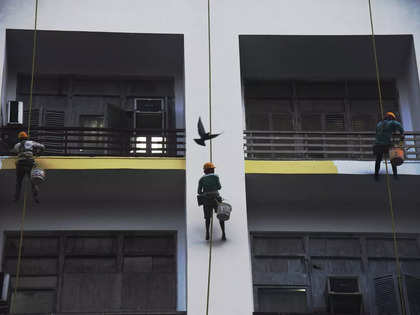
This was clearly a long overdue paint job. The patches were actually primer or plaster applied to repair the dents. I wondered where the workers were. Till I remembered it was a Sunday.
Things were quiet for the next two days and I forgot about the scaffolding. On Wednesday, as I sat down to work, I heard voices just outside my window. This startled me, since my desk windows are on the fourth floor, with a sheer drop of about 50 feet from window to ground. Looking outside, I saw a figure level with my window, sitting on a horizontal bamboo behind the veil of green. In his right hand was a brush that he dipped into a paint can suspended next to him. In his left hand, he had a mobile that he was using to give someone instructions about depositing an application in a local government office.
After a while, the man ended the call and put away the phone. Someone called down to him and he poked out his head from behind the net. A rope snaked down with a cloth bundle tied to it. The man untied the bundle and took out sandpaper with which he rubbed down a spot.
Over the next three weeks, I was constantly aware of these workers as they traversed across the cliff-face of the building, first putting an undercoat and then a two-colour final coat, working their way down from the sixth floor, nonchalantly balancing on the bamboos, with nothing to stop the fall should one of them lose their footing. The netting disappeared after a few days and I guessed it had been there not to shade the workers, but to protect the first coats from rain. No rain fell in April and these men worked through the hottest days of the year, suspended against a glaring bright wall with the summer sun beating down on them.
Inside my flat I carried on with my life, just as I could see people carrying on inside the building being painted. Between us, this daily, slow, surreal choreography on the bamboo grid continued as if invisible. Below the balancing painters and suspended masons, the cars kept turning into the driveway to the building entrance, disgorging their passengers before moving on.
Once, a worker dropped a coil of rope without looking. The clump fell to the ground, narrowly missing the rear windshield of a shiny new sedan as it drove past. Had it hit, it wouldn't have done any damage. But certainly there would have been furious shouting, a sudden puncturing of the obliviousness to the quietly perilous drama being enacted above.
Finally, once the paint job was complete, came the most hair-raising part: two men calmly began to take down the scaffolding the only way it could be done - while standing or sitting on it. Think of a man sitting on a branch applying a saw to a point of the branch between himself and the tree trunk, but doing this deliberately and mindfully. Through a series of practised manoeuvres, the pair loosened first one end of a horizontal bamboo and then, dropping down to the horizontal one below, the other end.
Then one of them tied the loosened bamboo with a rope and let it down to a man waiting below before repeating the whole process. Within 20 minutes, the last section of the scaffolding was gone, as were the workers. The building shone spotless in the sunlight. Almost spotless. From my window I could see where one of the painters had left footprints on a spanking white ledge.
Read More News on
(Catch all the Business News, Breaking News, Budget 2024 Events and Latest News Updates on The Economic Times.)
Subscribe to The Economic Times Prime and read the ET ePaper online.
Read More News on
(Catch all the Business News, Breaking News, Budget 2024 Events and Latest News Updates on The Economic Times.)
Subscribe to The Economic Times Prime and read the ET ePaper online.










 Get Unlimited Access to The Economic Times
Get Unlimited Access to The Economic Times
